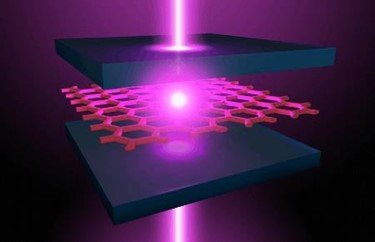Rochester Scientists Build Device That Can Create Particles With Negative Mass
By Jof Enriquez,
Follow me on Twitter @jofenriq

Scientists at the University of Rochester have built a device that can produce particles with a negative mass and may serve as a new substrate for producing lasers.
They embedded a single layer of the atomically thin semiconductor molybdenum diselenide (MoSe2) between top and bottom distributed Bragg reflectors (DBRs), which are essentially mirrors where lasers bounce off within an optical microcavity. In this setup, excitons from the semiconductor are made to interact with photons in the confined light to form polaritons — hybrid quasi-particles that are part light and part matter.
“By causing an exciton to give up some of its identity to a photon to create a polariton, we end up with an object that has a negative mass associated with it,” says Nick Vamivakas, an associate professor of quantum optics and quantum physics at Rochester’s Institute of Optics, and co-lead author of the study. “That’s kind of a mind-bending thing to think about, because if you try to push or pull it, it will go in the opposite direction from what your intuition would tell you.”
Other scientists have been trying to create conditions for negative mass in their experiments. For instance, a team at the University of Washington created a fluid with negative mass by cooling rubidium atoms to just a hair above absolute zero, creating what is known as a Bose-Einstein condensate.
No fundamental particle with negative mass has been discovered, and Rochester's is the first device to produce quasiparticles with negative mass in lab conditions.
Researchers are intrigued by the idea of objects with negative mass, which exhibit behavior that is counterintuitive to what we normally observe according to Newton’s Second Law of Motion, in which a force is equal to the mass of an object times its acceleration (F=ma). In other words, objects, when pushed, normally move forward. But those with negative mass will accelerate backwards when pushed, and vice versa.
“Our results suggest a pathway for studying interesting regimes in quantum many-body physics yielding possible new phases of quantum matter, as well as fresh possibilities for polaritonic device architectures,” the authors write in Nature Physics,
For now, the team at Rochester is still trying to figure out practical applications for their device.
“We’re dreaming up ways to apply pushes and pulls — maybe by applying an electrical field across the device — and then studying how these polaritons move around in the device under application of external force,” says Vamivakas.
Moreover, a new lasing method which requires just a small amount of power can be gleaned from their experiments to date.
“With the polaritons we’ve created with this device, the prescription for getting a laser to operate is completely different,” adds Vamivakas. “The system starts lasing at a much lower energy input” than traditional lasers now in use.”
